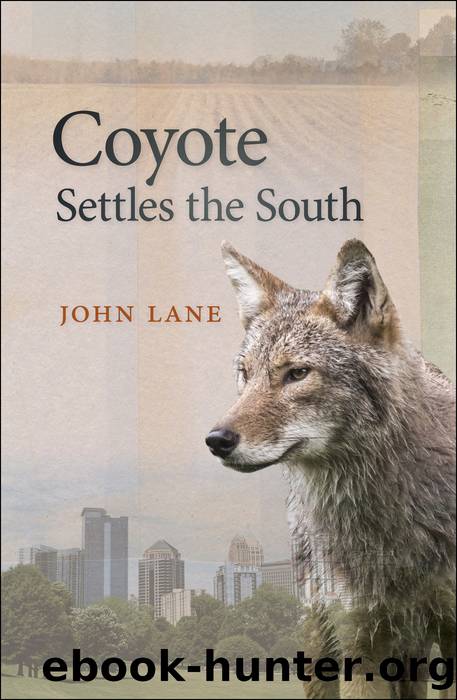Coyote Settles the South by Lane John;

Author:Lane, John;
Language: eng
Format: epub
Publisher: University of Georgia Press
Published: 2016-08-15T00:00:00+00:00
Dannyâs Field
If I hadnâa believed it, I wouldnâa seen it.
âAttributed to Mark Twain
Larry Stallings took us out to Dannyâs Field in Auburn Universityâs Solon Dixon Forestry Education Centerâs white Ford pickup. It was early in March and the morning sun rose straight ahead as we drove north on Route 29 in âL.A.â (Lower Alabama), forty miles from the Gulf of Mexico. We sat three abreast on the single bench seat and Larry narrated in his dry, flat Alabama drawl. Mike Willis sat in the middle with his hand cupped over his ear so he could hear what Larry was saying. I leaned into the passenger-side door taking notes. We passed Alabama forests and fields alternating in sections along the country road. âMost time you see âem in the fields,â Larry said. âI keep a rifle in the truck for hogs and coyotes. Most time itâs just one. If you see two itâs usually a male and a female.â
Mike and I were down from South Carolina for a week touring Solon Dixon to scare up whatever we could learn about Alabama coyotes. We were there as guests of Rhett Johnson, the retired director of the Solon Dixon Forestry Center. Iâd met Rhett in Spartanburg, where he lectured about longleaf pine ecosystems, and when he heard I was interested in coyotes, he invited me down to Alabama. He said heâd set me up with a place to stay at the center and take me out and to see the property. Mike Willis had a week off and wanted to tag along.
Iâll admit that when I first heard from Rhett that Auburn University has 5,300 acres of pine, hardwood, and river bottom swamp, I imagined that I might have finally hit on an eastern coyote Shangri-la. I thought the forest center might be a perfect refuge for the pioneering wild southern canines. I thought all that land might offer a spot where coyotes could live out their lives like predators on the wild plains of Africa, performing daily in a sort of blood drama produced by Walt Disney, some place like James Dickeyâs âThe Heaven of Animals,â where the wild prey and predators live âat the cycleâs center,â and where they could let âtheir instincts / wholly bloom.â
But on arrival I learned from Rhett that the work that goes on at Solon Dixon is much more complex than my cartoon wilderness tableau. At Solon Dixon the âcycleâs centerâ is managed with particular objectives in mind, and it has been managed that way for thirty years since the Dixon family gifted the former cutover timber plantation (at its time the largest gift ever by a living donor) to Auburn University.
The management objectives of the Solon Dixon are spelled out in the brochure about the center given to me upon arrivalâto provide quality natural resource education, a base for forest product research, and manage the resources of the center wisely and economically. For the first three decades Rhett carried out these objectives at Solon Dixon,
Download
This site does not store any files on its server. We only index and link to content provided by other sites. Please contact the content providers to delete copyright contents if any and email us, we'll remove relevant links or contents immediately.
Sapiens: A Brief History of Humankind by Yuval Noah Harari(13089)
The Tidewater Tales by John Barth(12040)
Do No Harm Stories of Life, Death and Brain Surgery by Henry Marsh(6346)
Mastermind: How to Think Like Sherlock Holmes by Maria Konnikova(6260)
The Thirst by Nesbo Jo(5804)
Why We Sleep: Unlocking the Power of Sleep and Dreams by Matthew Walker(5668)
Sapiens by Yuval Noah Harari(4561)
Life 3.0: Being Human in the Age of Artificial Intelligence by Tegmark Max(4526)
The Longevity Diet by Valter Longo(4458)
The Rules Do Not Apply by Ariel Levy(3920)
The Immortal Life of Henrietta Lacks by Rebecca Skloot(3838)
The Body: A Guide for Occupants by Bill Bryson(3831)
Why We Sleep by Matthew Walker(3784)
Animal Frequency by Melissa Alvarez(3764)
Yoga Anatomy by Kaminoff Leslie(3718)
Barron's AP Biology by Goldberg M.S. Deborah T(3640)
The Hacking of the American Mind by Robert H. Lustig(3591)
All Creatures Great and Small by James Herriot(3531)
Yoga Anatomy by Leslie Kaminoff & Amy Matthews(3414)
